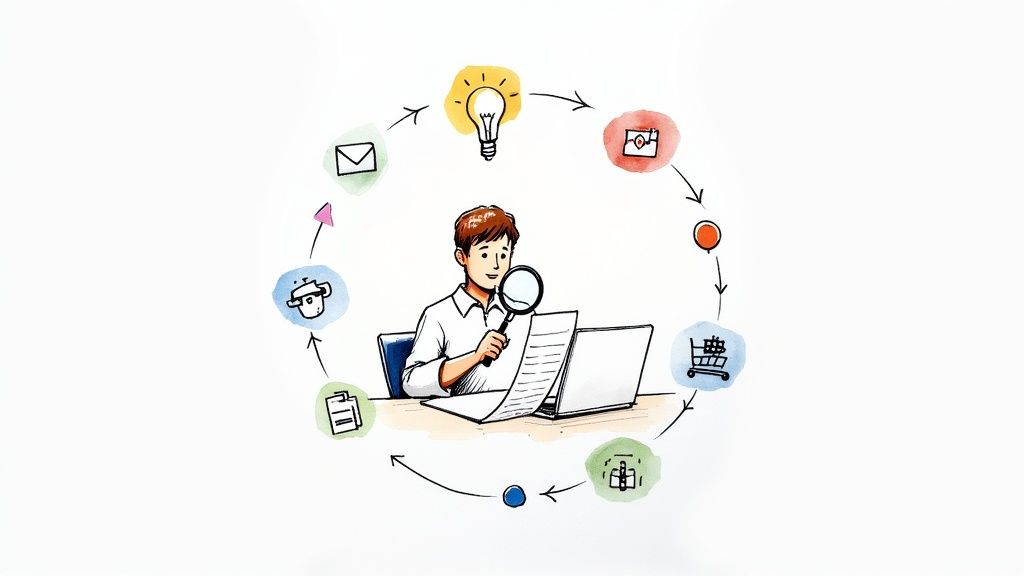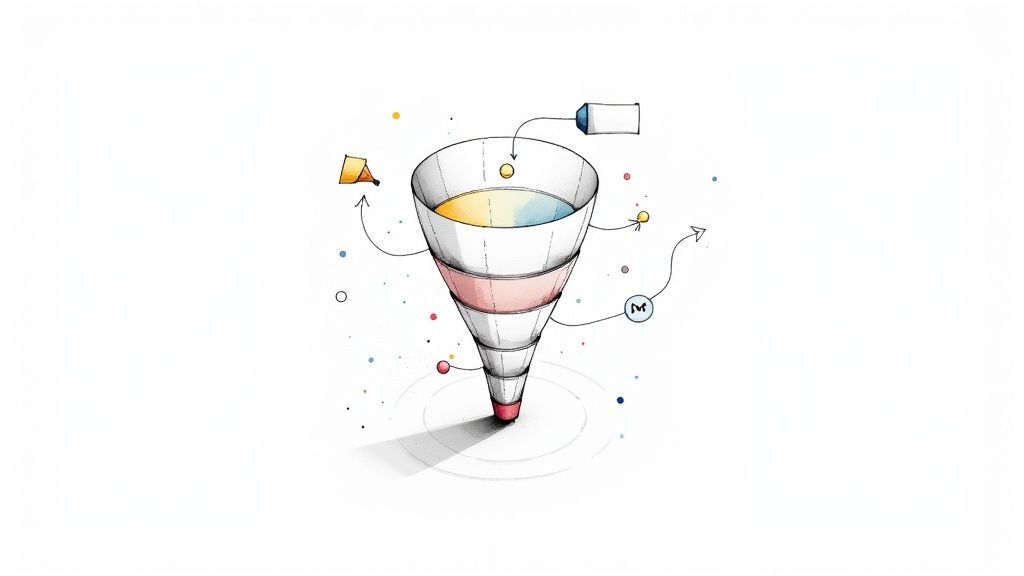
How to Improve Customer Engagement for SMBs
Discover how to improve customer engagement with practical strategies. Learn to personalize experiences, use AI, and build lasting customer loyalty.

A marketing funnel isn't just a buzzword; it's the path you create to guide someone from a total stranger to a happy customer. It’s all about putting the right content and offers in front of them at exactly the right time, from the moment they first hear about you to when they're ready to buy.
Before we dive into building something new, let's talk about what's probably broken with your existing setup. I see it all the time: businesses cling to these rigid, old-school funnel models that just don’t reflect how people actually shop and make decisions today. The result? You're leaving money on the table.
The single biggest mistake is assuming the customer journey is a clean, straight line. You throw some traffic at a landing page and just hope everyone follows the same script. But that's not reality.
The real customer journey is messy. It zigs and zags across different channels and touchpoints, often in an order you'd never predict. A one-size-fits-all approach doesn't just fail; it actively pushes away potential customers who don't fit into your neat little box.
Think about it from your customer's perspective. They might see one of your ads on Instagram, forget about it, then stumble upon a blog post you wrote a week later. After that, they might Google you to see how you stack up against competitors before they even think about making a purchase.
If you try to force them down a rigid path they aren't ready for, you create friction. And friction is where your funnel springs a leak.
The key is creating a flexible, customer-centric system that adapts to real-world behavior instead of forcing users down a path they don't want to take.
To start plugging those leaks, you first need to understand your baseline metrics. An average sales funnel converts between 3% and 10% from top to bottom, but that number can be deceiving. B2B funnels, for example, often land in the 1% to 5% range because the sales cycles are much longer.
Knowing these benchmarks helps you spot where your funnel is bleeding. Once you pinpoint those weak spots, you can make targeted improvements that actually move the needle. Getting these interactions right is a huge part of what we cover in our guide on conversion rate optimization best practices.
Let's get one thing straight: a killer marketing funnel doesn't start with software or fancy tools. It starts with empathy. Before you even draft a single headline or design a landing page, you have to get inside your customer's head and see the world through their eyes.
This means digging deeper than surface-level demographics. You need to know their real-world problems. What keeps them up at night? What are their biggest headaches at work? What specific phrases are they typing into a search engine when they're desperate for a solution?
This is the raw material for building buyer personas that feel like real people, not just a collection of data points. If you're new to this, we've got a great walkthrough on how to create buyer personas that can help.
Once you have that deep understanding, you can start identifying the crucial touchpoints where your brand can make a difference. Think about it:
Answering these questions is how you design a funnel that feels helpful, not pushy. You can meet them exactly where they are, with the right message at the right time. This is how you build trust, which is far more valuable than just pushing for a quick sale.
Remember, the goal isn't just to sell a product. It's to solve a problem for a real person who has a complex, non-linear path to finding a solution.
This infographic does a great job of showing how the customer journey has evolved from a rigid, old-school funnel into a more fluid, realistic path.

You can see how old, inflexible funnels "leak" customers because they don't account for how people actually behave. A modern, flexible funnel adapts to their needs, guiding them instead of forcing them down a single path.

This is your first handshake, the very top of the funnel (TOFU). It’s where you have to earn your audience's attention. Forget vague advice like "create great content." Let's get real about what it takes to stop the scroll and turn a complete stranger into someone who’s actually interested in what you have to say.
The first move is always figuring out where your ideal customers hang out online. Are they scrolling through specific LinkedIn groups, looking for professional advice? Or are they watching quick how-to videos on TikTok? Your channel choice dictates your content strategy, not the other way around. Once you know where they are, you can start creating things they'll genuinely find useful.
The path someone takes to find you has a huge impact on whether they’ll ever become a customer. Not all traffic is created equal, and some channels are just flat-out better at bringing in people who are ready to engage.
A lead from a referral is nearly three times more likely to convert than one from a cold call. This shows why focusing on channels that build trust and authority is so crucial for long-term success.
Take a look at how different channels perform when it comes to bringing people into a funnel. The numbers can be pretty eye-opening.
This table compares the average conversion rates for some of the most common marketing channels used to attract new leads.
As you can see, referrals are a powerhouse, converting at 25.56%, with email marketing not far behind at 22.83%. On the other hand, cold calling struggles with a 9.38% conversion rate. This data, which you can explore further in these stats on sales channel conversion rates, really drives home the need to focus on warmer, more trusted traffic sources from the get-go.
Here are a few ideas for TOFU content that actually work:
The goal here is simple: provide real help, no strings attached. That's how you build trust and become the go-to authority in their mind.

You’ve got their attention. Now the real work starts. This is where we move into the middle and bottom of your funnel, turning that initial spark of interest into a solid decision to buy. We're shifting gears from broad awareness to proving, without a doubt, that you’re the right choice.
This part of the journey is all about direct engagement and offering real substance. Think less about general blog posts and more about an in-depth case study that shows exactly how you solved a real-world problem for a business just like theirs. Webinars are also gold here—they give you a chance to talk directly to your audience and answer their toughest questions live.
As people get closer to making a choice, they're looking for reassurance. This is where a killer landing page makes all the difference. It needs sharp, persuasive copy, an unmissable call-to-action (CTA), and a whole lot of trust signals.
Testimonials, reviews, and client logos aren't just nice-to-haves. They're critical. They give a nervous buyer the confidence they need to finally pull the trigger.
Every touchpoint has to be optimized. Just adding social proof like customer reviews can lift your opt-in rates by 14% to 22%. That’s a huge jump, and it shows you just how much trust matters.
Desktop traffic often converts better than mobile. One analysis I saw found it was 1.7 times more likely to convert. While your site absolutely must work flawlessly on mobile, don't forget that a polished desktop experience is often where the final sale happens. You can dig into more conversion rate benchmarks by industry to see how you stack up.
Here are a few things I always recommend for this crucial stage:
Look, a great marketing funnel isn't something you just build and then walk away from. Think of it as a living, breathing part of your business—an engine for growth that needs constant fine-tuning. The real secret sauce is using data to see what’s hitting the mark and what’s falling flat. This is how you stop guessing and start building a predictable system for improvement.
It all starts with tracking the metrics that actually move the needle. You absolutely need to know your conversion rates from one stage to the next, your cost per acquisition (CPA), and the customer lifetime value (CLV). Sure, a tool like Google Analytics is fantastic for the big picture, but when you pair it with something like a heatmap, you can literally see where people are getting stuck and leaving your landing page.
Once that data starts rolling in, you can ask much smarter questions. Why are so many people ditching their carts right at the checkout page? Which blog posts are bringing in leads that actually turn into customers? Digging into the best social media analytics tools is also a must, as it gives you a much richer understanding of your audience beyond just what happens on your website.
This is also where AI really starts to shine. It's not just about looking at what happened yesterday; modern AI tools can actually help predict which of your leads are most likely to convert. Imagine your sales team knowing exactly who to focus on for the biggest impact. If you want to go deeper on this, check out our guide on how to use AI in marketing for some practical strategies.
The goal of optimization isn't just about making small tweaks. It’s about creating a feedback loop where every single customer interaction makes your funnel smarter and more effective.
The best way to put these insights into motion? A simple A/B testing framework. Test one thing at a time—the headline, the offer, even the color of your call-to-action button. Each test gives you a clear winner, and those small, incremental improvements really start to stack up over time, leading to some serious gains.
Even the most seasoned marketers had questions when they built their first funnel. Let’s walk through some of the common things that trip people up so you can move forward with confidence.
So, what’s the real difference between a B2B and a B2C funnel, anyway? While they share the same DNA—Awareness, Consideration, Conversion—they behave very differently. A B2C funnel is often a sprint, fueled by emotion and aimed at a single person making a relatively quick decision.
A B2B funnel, on the other hand, is a marathon. It’s a longer, more deliberate process because you're not just selling to one person. You’re convincing a whole team of stakeholders. This requires a completely different playbook, one filled with logical arguments, hard data, case studies, and a whole lot of trust-building.
One of the easiest traps to fall into is thinking you need a mountain of expensive software to make a funnel work. You really don't. In fact, overcomplicating things right out of the gate is a surefire way to get bogged down and lose momentum.
The best funnels I've ever seen weren't the most complex. They were the ones that were obsessively tracked and understood inside and out. Simplicity gives you clarity, and clarity lets you see exactly what's working and what's not.
If you’re just starting, you only need a few key pieces in your toolkit.
The goal here isn't to build the perfect, most elaborate funnel on day one. It's to build a simple, functional one, measure everything, and then let the data tell you what to improve next.
Ready to build a high-performance marketing funnel driven by real data and AI? At BrandBooster.ai, we deliver outcome-driven marketing solutions that guarantee returns. See real results in 60 days, or you don't pay. Start growing with BrandBooster.ai today.